I still remember my first taste of Balbacua on a rainy afternoon in Cebu, that moment when the rich, steaming bowl was placed before me at a small carinderia near Carbon Market.
The aroma alone brought instant comfort, reminding me of my Lola's kitchen. As I watched the tender meat falling off the cow trotters and the thick, collagen-rich broth coating my spoon, I knew this wasn't just another Filipino soup, it was pure comfort in a bowl.
Growing up in Luzon, I'd never experienced anything quite like this Visayan treasure, but that first spoonful of the savory broth, with its perfect balance of ginger, tomato, and black beans, instantly made me feel at home.
After countless attempts to recreate that unforgettable taste, I've finally perfected this Balbacua recipe that brings me right back to that cozy carinderia.
While it does require patience (believe me, those 3 hours of simmering are worth every minute), this hearty dish is surprisingly simple to make and budget-friendly, too.
This recipe promises to warm both your belly and your soul.
What is Balbacua?
Balbacua is a Filipino stew from Visayas and Mindanao that features cow trotters slow-cooked until tender in a rich, savory broth seasoned with aromatics, tomato sauce, and salted black beans. This collagen-rich dish sits at the intersection of pochero and kare-kare, offering deep flavors developed through patient cooking. While regional variations exist, most notably Cebu's version with peanuts and pineapple juice, the dish's essence lies in its transformation of humble ingredients into a comforting meal that showcases Filipino culinary expertise in extracting maximum flavor through slow cooking techniques.
Jump to:
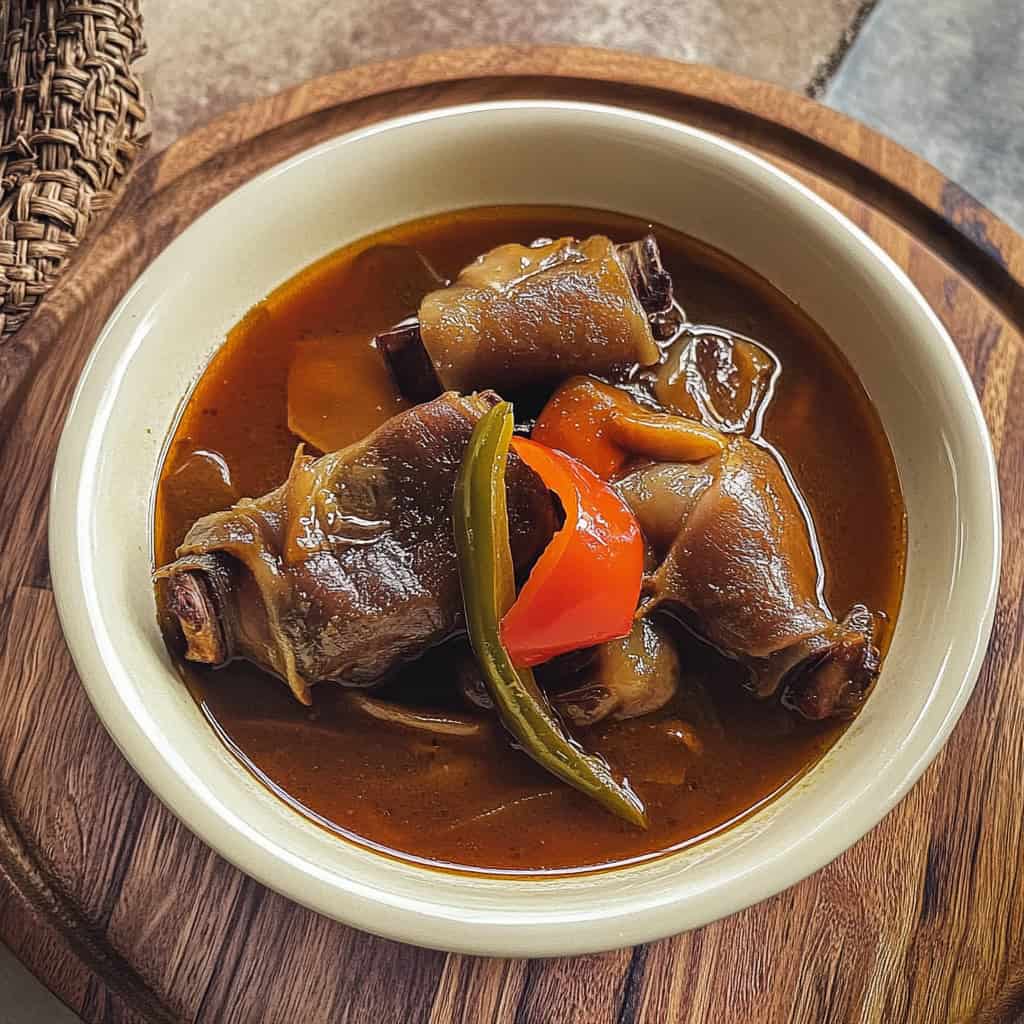
Why You'll Love This Recipe
- Rich in collagen and nutrients from slow-cooked cow trotters
- Perfect comfort food for cold weather
- Deeply satisfying umami flavor profile
- Budget-friendly yet impressive dish
- Similar to popular dishes like Pochero and Kare-kare
- Packed with health benefits from bone broth
Ingredients
The ingredients in this Balbacua recipe create the perfect harmony of flavors and textures. Cow trotters provide rich collagen that transforms into a velvety broth during the long simmer, while aromatic elements like garlic, ginger, and lemongrass build a fragrant foundation.
Salted black beans contribute essential umami depth, and tomato sauce adds a subtle tanginess that balances the richness. The annatto powder gives the stew its distinctive warm color, while jalapeños and bell peppers add brightness and a gentle heat. Green onions finish the dish with a fresh counterpoint to the deeply savory base.
Every component serves a purpose, working together to create a dish that's greater than the sum of its parts - a true testament to Filipino cooking's genius for transforming humble ingredients into extraordinary meals.
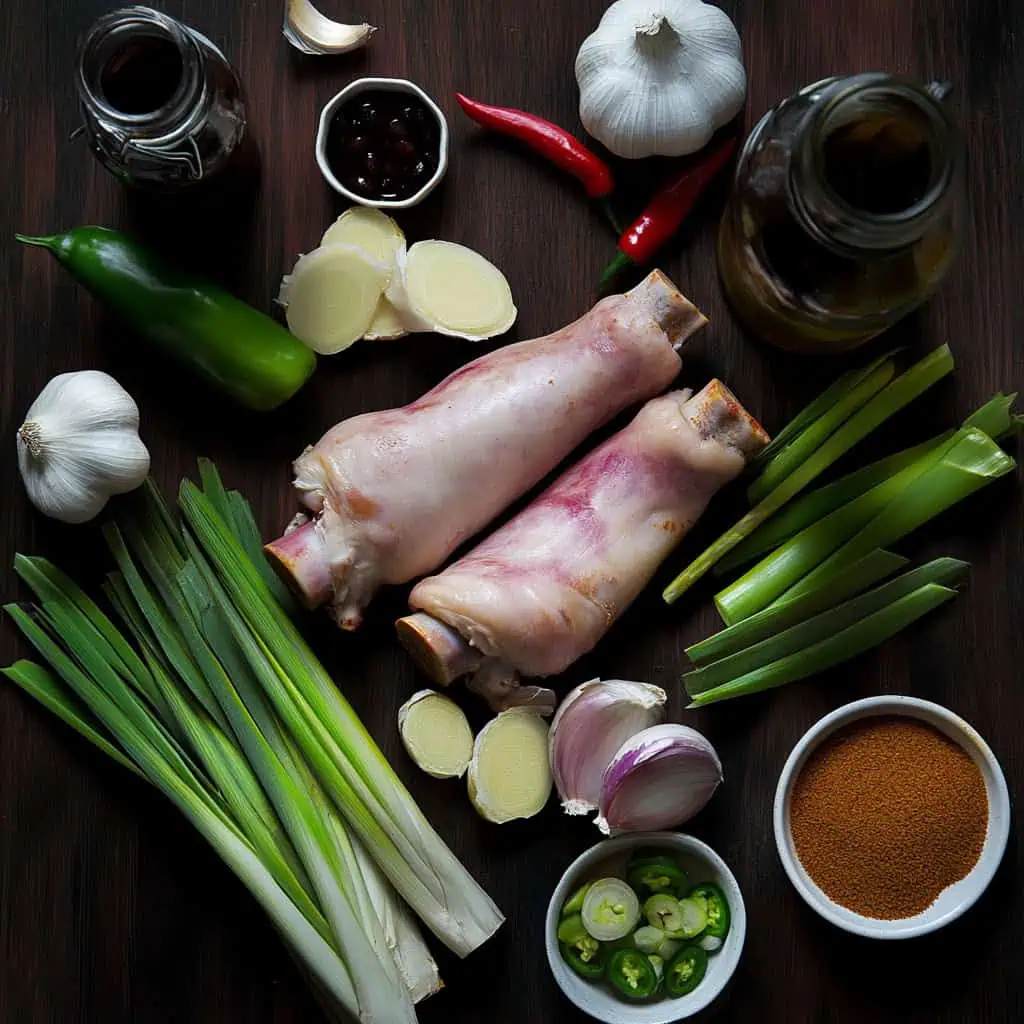
- 5 lbs cow trotters (paa ng baka)
- 10 cups water
- 1 Knorr Beef Cube
- 1 bunch lemongrass, white part cut in 4-inch pieces
- 1 teaspoon ground black pepper
- 5 cloves garlic, crushed
- 1 onion, chopped
- 2 knobs ginger, crushed
- 3 tablespoons cooking oil
- 2 teaspoons annatto powder
- 3 tablespoons salted black beans (tausi)
- Fish sauce to taste
- 8 ounces tomato sauce
- 1 bell pepper, sliced
- 3 Jalapeño peppers
- 1 bunch green onions, cut in 2-inch pieces
Equipment Needed
- Large stockpot or Dutch oven (kaldero) - For slow cooking the trotters with ample space for the broth to develop
- Sharp knife (kutsilyo) - For preparing ingredients with precision
- Wooden spoon (sandok na kahoy) - For stirring without scratching the pot and maintaining the broth's clarity
- Strainer (Salaan) - For cleaning the trotters thoroughly and removing impurities
- Heavy-bottom pan - For properly sautéing aromatics to develop flavor
- Measuring cups and spoons (Panukat) - For precise measurements to achieve balanced flavors
- Cutting board (Sangkalan) - For safe and hygienic food preparation

How To Make
- Prepare the trotters: Thoroughly clean the cow trotters under cold running water. Remove any excess hair or debris. Soak them in vinegar water for 15 minutes to remove any gamey smell (malansa). Pat dry with paper towels.
- Prep the ingredients: While the trotters are soaking, crush the garlic, chop the onion, crush the ginger, cut the lemongrass into 4-inch pieces, slice the bell pepper into strips, and cut green onions into 2-inch lengths.
- Begin the slow cook: In a large pot over high heat (220°C/430°F), combine the clean trotters with water, black pepper, and lemongrass. Bring to a rolling boil, then immediately reduce heat to low (120°C/250°F). Skim off any scum that rises to the surface.
- Simmer patiently: Let the mixture simmer on low heat for 3 hours, checking occasionally and skimming when needed. The meat should become very tender and start to fall off the bone. Keep the pot partially covered and maintain the liquid level by adding hot water if necessary.
- Prepare the aromatics: When you reach the 3-hour mark, heat oil in a separate pan over medium heat. Sauté the crushed garlic until light golden, then add the chopped onions and ginger. Cook until the onions become translucent and fragrant. Set aside.
- Enhance the broth: Remove the lemongrass pieces from the main pot. Add the sautéed aromatics, annatto powder, salted black beans, and beef cube to the simmering broth. Continue cooking for 30 minutes at low heat.
- Add vegetables: Add the sliced bell pepper, jalapeño peppers, and green onions. Cook for another 10 minutes. Season with fish sauce to taste.
- Final check: Ensure the meat easily falls off the bone and the broth is rich and slightly thick. Test the seasoning and adjust if needed.
- Rest before serving: Turn off the heat and let the Balbacua rest for 5 minutes before serving. This allows the flavors to settle and the temperature to become perfect for eating.

Tips from Lola's Kitchen
- Pre-boil technique: Boil the trotters in water for 5 minutes, discard the water, then start fresh with new water for the actual cooking. This removes impurities and results in a clearer broth.
- Soak with purpose: Add a tablespoon of salt to your vinegar water soak to further eliminate any unwanted odors from the trotters.
- Depth of flavor: Toast the black beans in a dry pan for 1-2 minutes before adding them to release their aromatic oils.
- Overnight magic: For truly spectacular results, prepare this dish a day ahead and refrigerate overnight. The flavors will deepen significantly.
- Managing heat: Use a heat diffuser under your pot during the long simmer to prevent hot spots that might cause the bottom to scorch.
- Maximize umami: Add a small piece of dried kombu (seaweed) during the first hour of simmering for enhanced depth of flavor, then remove before serving.
- Collagen extraction: The true test of properly cooked balbacua is when the broth gels when refrigerated – this indicates optimal collagen extraction.
Substitutions
- Cow trotters: Oxtail, beef shanks, or beef tendon can be used if trotters aren't available
- Lemongrass: 2 bay leaves and a teaspoon of lemon zest provide a similar aromatic profile
- Knorr cube: Natural beef bone broth or 2 tablespoons of beef bouillon powder
- Jalapeños: Long green chilies, siling haba, or additional bell peppers for less heat
- Salted black beans: 2 tablespoons of soy sauce plus 1 tablespoon of fermented black bean paste
- Annatto powder: 1 teaspoon paprika plus ½ teaspoon turmeric for color and subtle flavor
- Tomato sauce: 4 tablespoons of tomato paste diluted in ½ cup water
Troubleshooting
- Broth too thin: Continue simmering uncovered to reduce the liquid, or add a slurry of 1 tablespoon cornstarch mixed with 2 tablespoons cold water.
- Trotters not tender enough: Continue simmering in 30-minute increments until the meat easily separates from the bone. Some cuts may require up to 5 hours total.
- Too salty: Add 2-3 quartered potatoes to absorb excess salt, then remove them. Alternatively, add a splash of vinegar to balance the saltiness.
- Greasy surface: Refrigerate overnight and remove the solidified fat layer from the top before reheating.
- Cloudy broth: Strain through a fine-mesh sieve lined with cheesecloth, then return to a clean pot.
- Not enough flavor: Consider adding 1 tablespoon of fish sauce, a splash of Worcestershire sauce, or a teaspoon of MSG to enhance umami notes.
- Too spicy: Add a tablespoon of brown sugar and a quarter cup of coconut milk to temper the heat.
Storage & Reheating
- Refrigeration: Store in an airtight container for up to 4 days. The flavors will actually improve after the first day.
- Freezing: Portion into freezer-safe containers, leaving room for expansion, and freeze for up to 3 months.
- Thawing: Thaw overnight in the refrigerator for best results.
- Reheating on stovetop: Place in a pot over medium-low heat, adding ¼ cup of water to thin the broth if needed. Stir occasionally until it reaches 165°F (74°C).
- Microwave reheating: Cover with a microwave-safe lid or paper towel and heat on medium power in 2-minute intervals, stirring between each until thoroughly heated.
- Quality tip: When reheating, add a fresh handful of sliced green onions just before serving to brighten the dish.
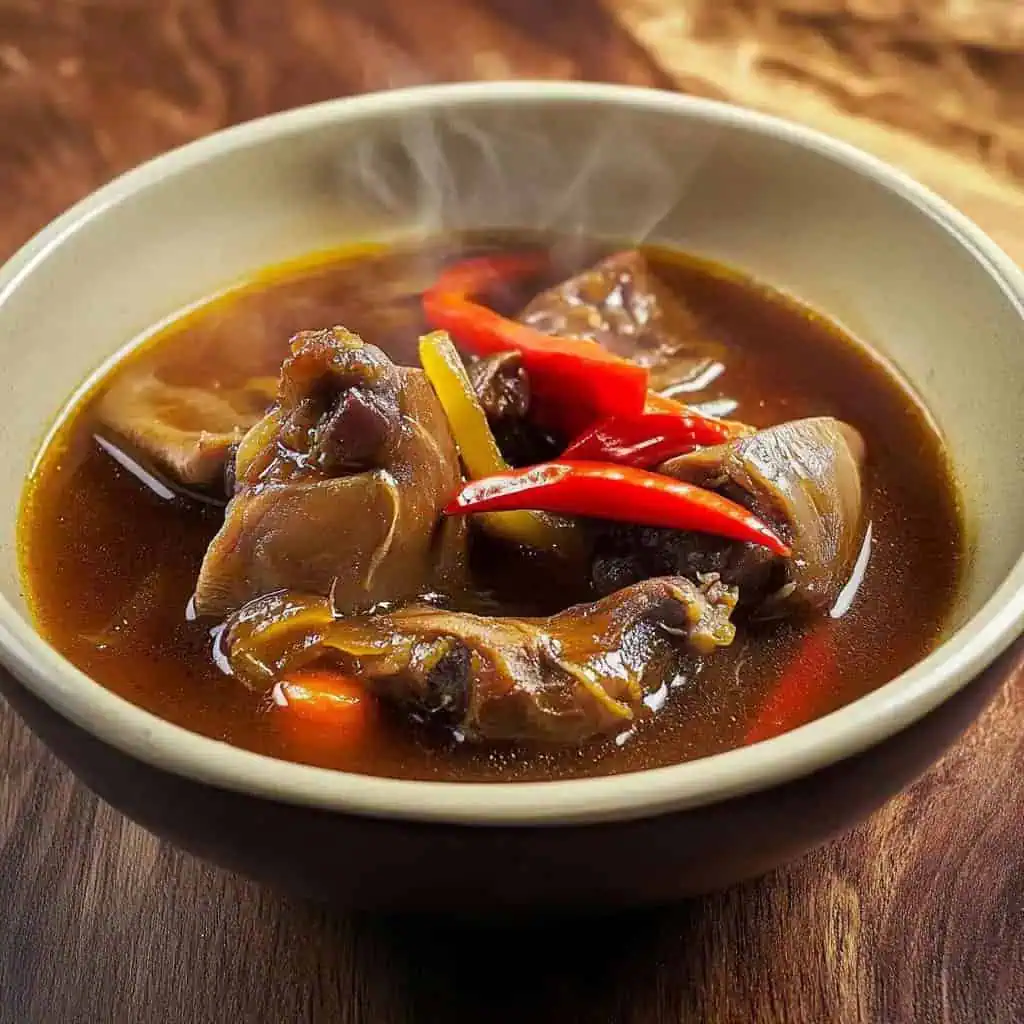
FAQ
Why does it take so long to cook?
The extended simmering time is necessary to break down the tough collagen in the trotters into gelatin, creating the signature rich, velvety texture of authentic balbacua.
Can I use a pressure cooker?
Yes, you can reduce the cooking time to about 60-75 minutes on high pressure. However, the traditional slow-simmered version develops deeper flavor complexities.
Is this dish healthy?
Absolutely. Balbacua is rich in collagen, which supports joint health, and minerals extracted from the bones during slow cooking. It's a nutrient-dense dish with numerous health benefits.
Can I make this in advance for a party?
Not only can you make it ahead, but it's preferable! The flavors continue to develop overnight, making balbacua ideal for preparing 1-2 days before your event.
Why isn't my broth thickening?
Ensure you're simmering at the right temperature. Too low, and collagen won't extract properly; too high, and it might break down too much. Also, make sure your trotters have enough cartilage and skin attached.
How do I know when the trotters are perfectly done?
The meat should easily pull away from the bone with minimal resistance, and the tendons should have a soft, gelatinous texture that melts in your mouth.
Can I add vegetables like carrots or potatoes?
While not traditional, root vegetables can be added during the last 30 minutes of cooking. Just be aware they'll absorb some of the broth's flavors.
What's the difference between Cebuano and other regional versions?
The Cebuano version typically includes ground peanuts and sometimes pineapple juice for a slightly sweeter, nuttier profile, while other regions might emphasize different aromatics or levels of spiciness.
Related
Looking for other recipes like this? Try these:
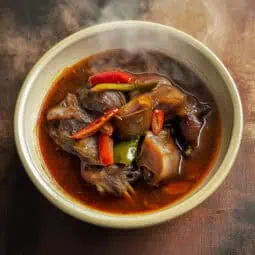
Authentic Filipino Balbacua Recipe (Bulbacua/Balbakwa)
Equipment
- Large stockpot or Dutch oven (kaldero) for slow cooking the trotters
- Sharp knife (kutsilyo) for preparing ingredients
- Wooden spoon (sandok na kahoy) for stirring without scratching the pot
- Strainer [Salaan] for cleaning the trotters
- Heavy-bottom pan for sautéing aromatics
- Measuring cups and spoons (Panukat) for precise measurements
- Cutting board (Sangkalan)
Ingredients
For the Broth Base
- 5 lbs cow trotters paa ng baka
- 10 cups water tubig
- 1 Knorr Beef Cube pantasa
- 1 bunch lemongrass white part cut in 4-inch pieces (tanglad)
- 1 teaspoon ground black pepper dinurog na paminta
For the Aromatics
- 5 cloves garlic crushed (bawang, dinurog)
- 1 onion chopped (sibuyas)
- 2 knobs ginger crushed (luya, dinurog)
- 3 tablespoons cooking oil mantika
For Flavoring and Color
- 2 teaspoons annatto powder atsuete
- 3 tablespoons salted black beans tausi
- Fish sauce to taste patis
- 8 ounces tomato sauce sarsa ng kamatis
Vegetables
- 1 bell pepper sliced (siling pula)
- 3 Jalapeño peppers siling verde
- 1 bunch green onions cut in 2-inch pieces (sibuyas dahon)
Instructions
Balbacua Recipe Instructions
- Start by thoroughly cleaning the cow trotters (paa ng baka) under cold running water. Remove any excess hair or debris. For best results, soak them in vinegar water for 15 minutes to remove any gamey smell (malansa). Pat dry with paper towels.
- While the trotters are soaking, prepare your ingredients: crush 5 cloves of garlic (dinurog na bawang), chop 1 onion into small pieces, crush 2 knobs of ginger (dinurog na luya), cut the white parts of lemongrass into 4-inch pieces, slice the bell pepper into strips, and cut green onions into 2-inch lengths.
- In a large pot over high heat (220°C/430°F), combine the clean trotters with 10 cups of water, 1 teaspoon ground black pepper, and the prepared lemongrass. Bring to a rolling boil, then immediately reduce heat to low (120°C/250°F). Skim off any scum that rises to the surface (alisin ang bula).
- Let the mixture simmer on low heat for 3 hours, checking occasionally and skimming when needed. The meat should become very tender and start to fall off the bone. Keep the pot partially covered and maintain the liquid level by adding hot water if necessary.
- When you reach the 3-hour mark, heat 3 tablespoons of oil in a separate pan over medium heat (160°C/320°F). Sauté the crushed garlic until light golden, then add the chopped onions and ginger. Cook until the onions become translucent and fragrant. Set aside.
- Remove the lemongrass pieces from the main pot. Add the sautéed aromatics, 2 teaspoons of annatto powder (atsuete), 3 tablespoons of salted black beans (tausi), and 1 Knorr beef cube to the simmering broth. Continue cooking for 30 minutes at low heat (120°C/250°F).
- Add the sliced bell pepper, 3 jalapeño peppers, and cut green onions. Cook for another 10 minutes. Season with fish sauce (patis) to taste.
- Do a final check - the meat should easily fall off the bone (dapat malambot na) and the broth should be rich and slightly thick. Test the seasoning and adjust if needed.
- Turn off the heat and let the Balbacua rest for 5 minutes before serving. This allows the flavors to settle and the temperature to become perfect for eating.
CHEF'S NOTES:
- Always maintain a gentle simmer - never boil on high heat after the initial boiling stage
- Stir gently to keep the meat intact
- The broth will naturally thicken from the collagen in the trotters
- If the broth becomes too thick, add hot water a little at a time
- Remember that the saltiness from the black beans and beef cube will concentrate as it cooks, so taste before adding more seasoning
- For extra richness, you can add peanuts (Cebuano style) during step 6
Tips from Lola's Kitchen
- Soak the trotters in vinegar water for 15 minutes before cooking to remove any gamey smell (malansa)
- Don't skip the long simmering time - this develops the rich collagen that makes the soup creamy
- Add peanut butter for a Cebuano variation
- Toast the annatto seeds in oil first for deeper color and flavor
Nutrition
The Story Behind Balbacua
Deep in the heart of Visayas and Mindanao lies a culinary treasure that speaks volumes about Filipino ingenuity and resourcefulness. Balbacua, also known as bulbacua or balbakwa in different regions, emerged as a testament to our ancestors' wisdom in transforming humble ingredients into extraordinary dishes. This hearty stew, centered around slowly cooked cow trotters, carries not just flavors but generations of Filipino culinary heritage.
The origins of balbacua can be traced back to the Spanish colonial period, when local cooks were tasked with making use of every part of the livestock. While the choice cuts went to the privileged class, innovative Filipino cooks discovered that the collagen-rich trotters, when slowly simmered for hours, yielded an incredibly rich and flavorful broth. This cooking method, reminiscent of the Spanish cocido, was adapted to local tastes and ingredients, giving birth to what we now know as balbacua.
In Cebu, where the dish gained significant popularity, locals added their unique twist by incorporating ground peanuts and sometimes pineapple juice, creating a flavor profile that bridges the gap between pochero and kare-kare. The dish became a staple in carinderias across the Visayas region, particularly cherished during the cold, rainy season when its warming properties brought comfort to workers and families alike.
What makes balbacua truly special is its transformation over time. From a humble dish born of necessity, it has evolved into a celebrated delicacy that showcases the essence of Filipino cooking – patience, resourcefulness, and the ability to create something extraordinary from simple ingredients. Today, you'll find variations of balbacua across different regions, each adding their own local ingredients while maintaining the dish's soul-warming character.
Modern Filipino food culture has seen a renewed appreciation for traditional dishes like balbacua, particularly as more people recognize its health benefits. The collagen-rich broth, slow-cooked to perfection, aligns with contemporary interest in bone broth and its numerous health properties. This convergence of traditional wisdom and modern nutritional knowledge has helped elevate balbacua from a regional specialty to a dish worthy of national recognition.
Whether served in a modest carinderia in Carbon Market, Cebu, or prepared in home kitchens across the Philippines, balbacua remains a shining example of Filipino culinary heritage. It's a dish that tells the story of our people – resourceful, patient, and capable of creating moments of pure comfort through food. As we continue to celebrate Filipino cuisine on the global stage, balbacua stands as a proud reminder of our rich culinary traditions and the endless possibilities that come from honoring our food heritage.
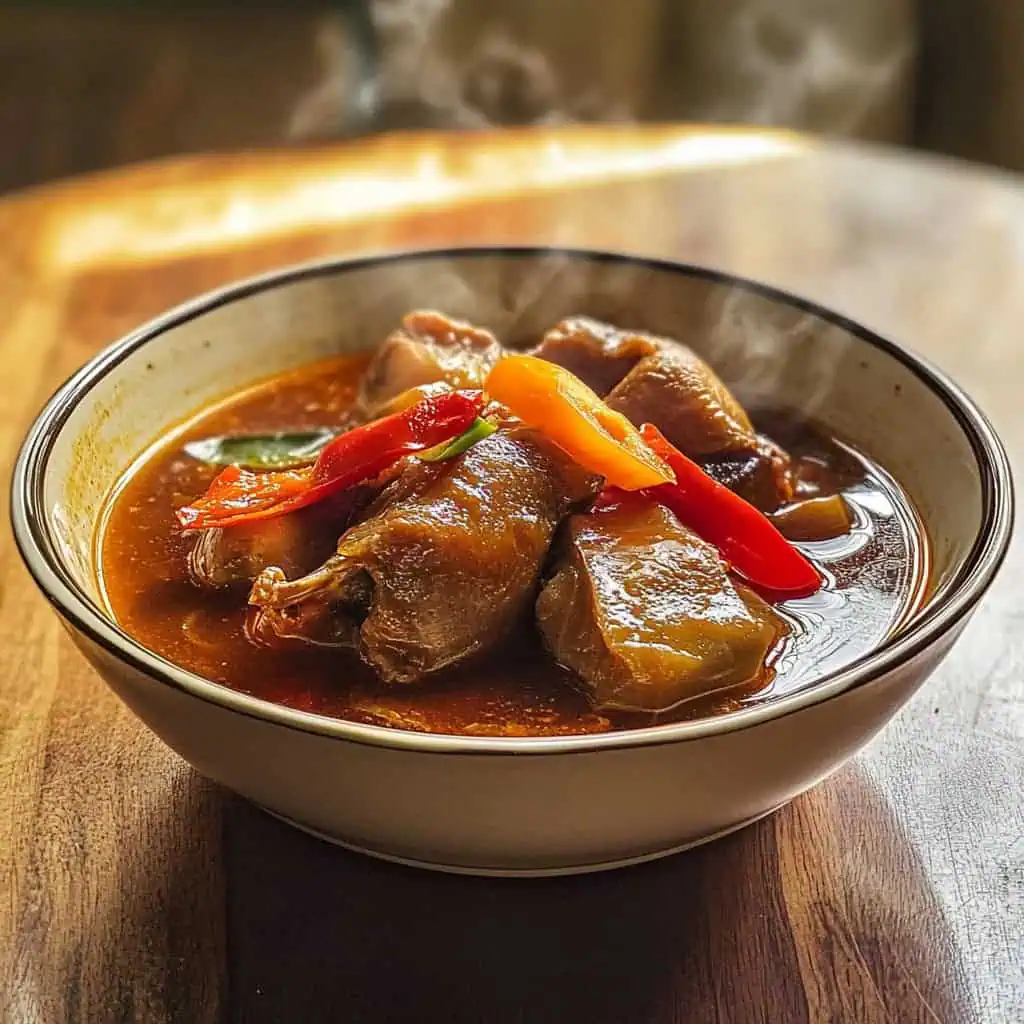





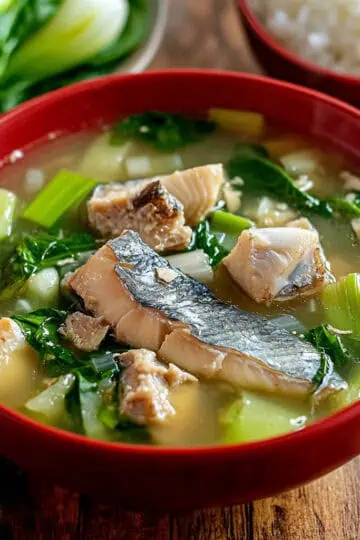
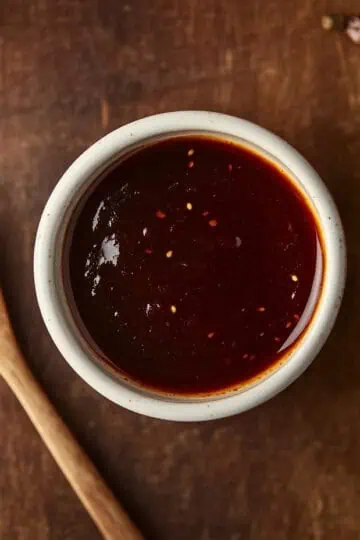
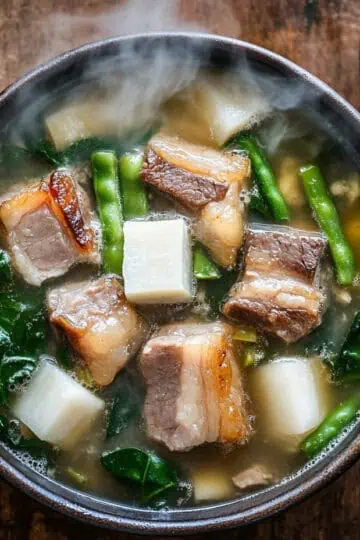
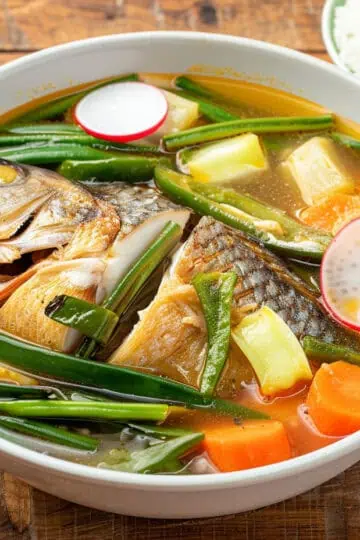
Comments
No Comments